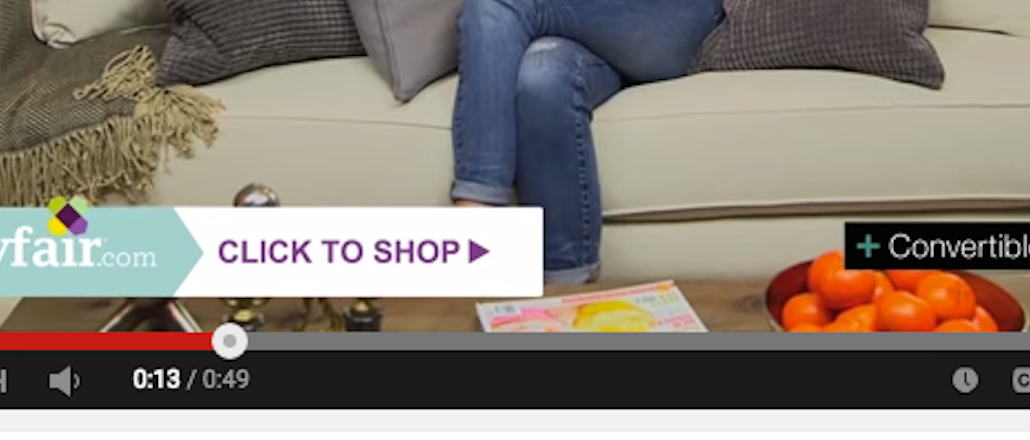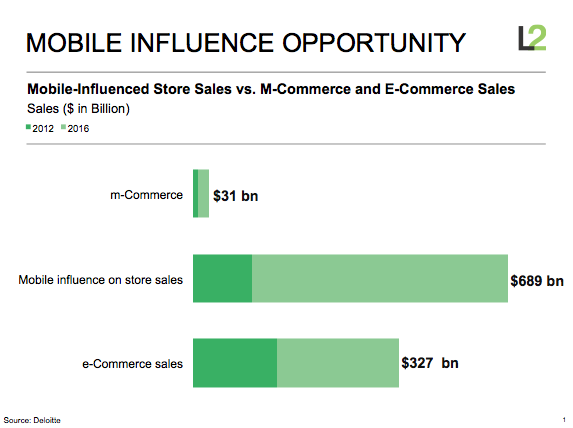A tale of two ad products: YouTube’s shoppable ads vs. Google’s click-to-buy button

As the number of Google’s desktop searches declines, the engine has turned its sights on mobile. This month, Google rolled out two new mobile ad products to facilitate faster m-commerce sales: click-to-buy buttons in search and shoppable ads on YouTube videos.
The differences between the two products are subtle but significant: The click-to-buy buttons are designed to drive sales seamlessly, but YouTube’s shoppable ads appear to be more about driving a brand’s mobile influence.
As such, while both ad models minimize the number of clicks mobile shoppers need to get to the checkout page, the buy button has the edge over shoppable YouTube ads. Placed next to product search results, the click-to-buy button brings shoppers directly to a Google checkout page, enabling one-click purchases, a major improvement for seamless mobile shopping.
With the click-to-shop ads, YouTube sends users to the retailer’s product page, leaving the checkout process in the hands of the retailer and creating a fuzzier path to purchase than the direct-to-checkout buy buttons. The mobile sale is still at the whim of the retailer’s mobile website.
“When you’re searching videos on your phone, it’s relevant to what you’re doing at that time,” said Mabel McLean, research and advisory associate at L2. “It’s a huge influence driver: one click to find out exactly what a product is, how much it costs and where to find it. M-commerce, in that format, isn’t at the forefront.”
Still, when it comes to cracking mobile commerce, anything is an improvement for retailers, according to adMarketplace’s vp of business development Vince Meyer.
“Generating leads through mobile influence makes a lot of sense for retailers,” said Meyer. “To be frank, anything new is going to be better than what they have now on mobile.”
Before, consumers watching product-heavy videos like reviews and tutorials would have to migrate from YouTube to Google in order to search for something they saw and wanted to buy. Now, when the clickable product ads pop up (in an overlay format, similar to the text ads that appear in videos), the viewer can go from video to product page with one click.
Wayfair and Sephora, which both tested the ads in beta, have seen positive results. At first, Wayfair was wary of how much YouTube could drive impressions for its demographic of 35- to -64-year-old women, said Ben Young, the company’s media manager of TV and online video. But after incorporating the shoppable ads, it plans to generate more original video content.
“People want specific products seen in the videos, and this gives them a direct avenue,” said Young. Going forward, he said, the content team will incorporate the shoppable ads into their video strategy, like having the on-screen actor point to where the ad will be and remind customers they can buy using that button.
Google boasted in a blog post that Wayfair reported a 300 percent revenue increase per impression with the shoppable ads. Sephora, which specializes in beauty tutorials, saw an 80-percent lift in consideration and a 54-percent lift in ad recall. Google also pointed out that 50 percent of YouTube views happen on mobile.
“The scale of mobile influence doesn’t even compare to the scale of purchases, so that’s where we’re seeing mobile optimization,” said L2’s McLean. “Rather than for pure commerce, people are using their phones for research.”

Meyer added that while we’ll have to see how the shoppable ads roll out on YouTube in the long term, we can count on Google to continue down the path as an e-commerce player.
“Ten years ago, Google wanted to be at the start of the user’s journey on the Web. Now they want to be as close as possible to e-commerce conversions. It’s an interesting situation, where Google is blurring the lines.”
More in Marketing

What TikTok’s e-commerce launch could mean for marketers and content creators
TikTok has officially launched its new e-commerce platform, TikTok Shop, earlier this month on August 1. Using the new e-commerce platform, brands and creators can sell products directly on the platform, potentially creating new revenue streams, and tap into the short-form video platform’s growing popularity.

‘The influencer industry can be really vile’: Confessions of an influencer marketer on the industry’s unfair hiring practices
While the influencer industry might sound exciting and like it’s full of opportunities, one marketer can vouch for the horrific scenarios that still take place behind the scenes.

Digiday+ Research: Marketers said revenue grew in the last year, with more growth expected ahead
After a tumultuous 12 months, marketers are getting a clear picture of how they really did during a time of true uncertainty. And, as it turns out, it wasn’t all that bad.
Ad position: web_bfu